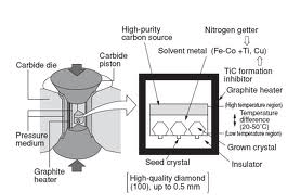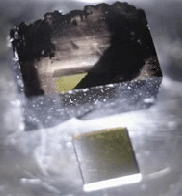Special Techniques for Manufacturing Synthetic Diamonds
On this page you can read about techniques used for manufacturing Synthetic or Man made diamond.
The two most widely used methods are:
- High pressure high temperature (HTHP)
- Chemical vapor deposition (CVD)
High Pressure High Temperature (HPHT)
This is the oldest method and is still widely used because of its cost-effectiveness. In this method seed ingredient (tiny fragments of charcoal) are exposed to the extremely high temperature and pressure (conditions same as under which natural diamonds are formed).
Through this technique, it takes 7-10 days for diamond to reach its final state.
There are 3 main press designs used to create the HPHT environment:
- Belt Press – It uses upper and lower carbide anvils to supply pressure and an electric current is passed to attain a temperature in the range of 1,200 to 1,500 degrees Celsius.
 |
| Schematic View of HPHT Belt Press |
- Cubic Press - It has 6 anvils which provide operating pressure in cube shaped volumes.
- Split-sphere (BARS) - It’s the most economical and effective method for manufacturing of man-made diamonds. Seed ingredients are locked in disc-shaped barrel with 1 m diameter. Barrel is then filled with oil and heat is applied to expose it to high temperature and pressure.
Chemical Vapor Deposition (CVD)
This method has been widely researched world over since early 1980’s and it has gained popularity in recent times due to its simplicity and flexibility.
Chemical impurities and properties of the synthetic diamond can be controlled through this method.
In this technique, the chemical reaction takes place and carbon plasma (carbon region containing balanced charges of icons and electrons) gets deposited over a layer, atom by atom to form diamond.
 |
| Diamond Formed by CVD Technique |
New methods of manufacturing Synthetic Diamond
Detonation Synthesis
This method entered the market in 1990’s and is widely used in China and Russia. In this process, nano-sized diamond grains are formed in explosion of carbon containing explosives. This nano diamond powder is mainly used for polishing purpose.
Ultrasound Cavitation
In this method, graphite is suspended in an organic liquid at high temperature and pressure using ultrasonic cavitations. Micron-sized diamond crystals are produced, which is 10% of the amount of graphite used. This process has been performed in laboratory but not used commercially.
Return from Special Techniques to Synthetic Diamonds page
Return from Special Techniques to Diamond Jewelry Homepage
I hope you'll not mind sharing this on Twitter, Facebook and with everyone else :)
Feel free to share if something is in your mind and want it to be covered on this site.
My Newsletter
Did you liked this article? Sign-up my FREE weekly newsletter and I'll send you more awesome new additions on this website along with latest jewelry happenings around the world, and download my Jewelry Design Album for FREE!
 |
|


